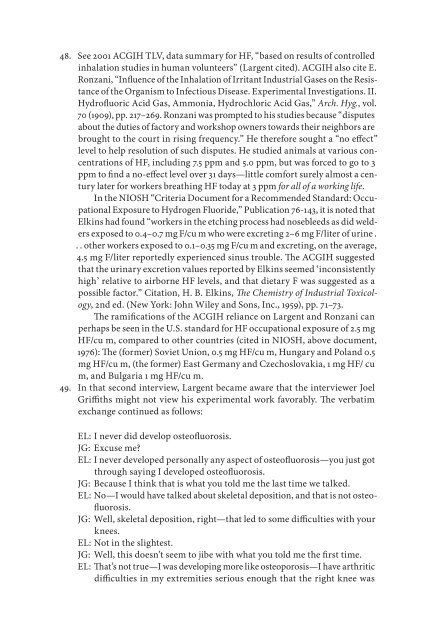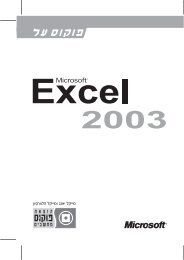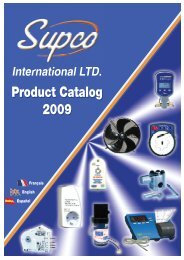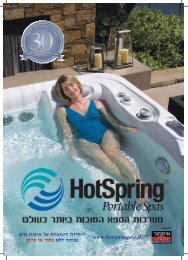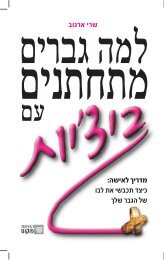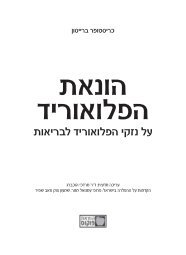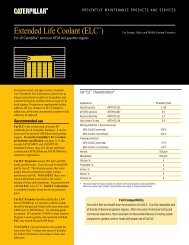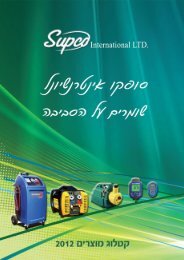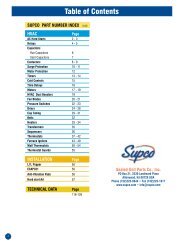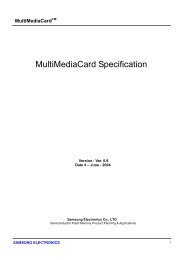Epigraphs Note on Terminology Acknowledgments Introduction
Epigraphs Note on Terminology Acknowledgments Introduction
Epigraphs Note on Terminology Acknowledgments Introduction
Create successful ePaper yourself
Turn your PDF publications into a flip-book with our unique Google optimized e-Paper software.
48. See 2001 ACGIH TLV, data summary for HF, “based <strong>on</strong> results of c<strong>on</strong>trolled<br />
inhalati<strong>on</strong> studies in human volunteers” (Largent cited). ACGIH also cite E.<br />
R<strong>on</strong>zani, “Influence of the Inhalati<strong>on</strong> of Irritant Industrial Gases <strong>on</strong> the Resistance<br />
of the Organism to Infectious Disease. Experimental Investigati<strong>on</strong>s. II.<br />
Hydrofluoric Acid Gas, Amm<strong>on</strong>ia, Hydrochloric Acid Gas,” Arch. Hyg., vol.<br />
70 (1909), pp. 217–269. R<strong>on</strong>zani was prompted to his studies because “disputes<br />
about the duties of factory and workshop owners towards their neighbors are<br />
brought to the court in rising frequency.” He therefore sought a “no effect”<br />
level to help resoluti<strong>on</strong> of such disputes. He studied animals at various c<strong>on</strong>centrati<strong>on</strong>s<br />
of HF, including 7.5 ppm and 5.0 ppm, but was forced to go to 3<br />
ppm to find a no-effect level over 31 days—little comfort surely almost a century<br />
later for workers breathing HF today at 3 ppm for all of a working life.<br />
In the NIOSH “Criteria Document for a Recommended Standard: Occupati<strong>on</strong>al<br />
Exposure to Hydrogen Fluoride,” Publicati<strong>on</strong> 76-143, it is noted that<br />
Elkins had found “workers in the etching process had nosebleeds as did welders<br />
exposed to 0.4–0.7 mg F/cu m who were excreting 2–6 mg F/liter of urine .<br />
. . other workers exposed to 0.1–0.35 mg F/cu m and excreting, <strong>on</strong> the average,<br />
4.5 mg F/liter reportedly experienced sinus trouble. The ACGIH suggested<br />
that the urinary excreti<strong>on</strong> values reported by Elkins seemed ‘inc<strong>on</strong>sistently<br />
high’ relative to airborne HF levels, and that dietary F was suggested as a<br />
possible factor.” Citati<strong>on</strong>, H. B. Elkins, The Chemistry of Industrial Toxicology,<br />
2nd ed. (New York: John Wiley and S<strong>on</strong>s, Inc., 1959), pp. 71–73.<br />
The ramificati<strong>on</strong>s of the ACGIH reliance <strong>on</strong> Largent and R<strong>on</strong>zani can<br />
perhaps be seen in the U.S. standard for HF occupati<strong>on</strong>al exposure of 2.5 mg<br />
HF/cu m, compared to other countries (cited in NIOSH, above document,<br />
1976): The (former) Soviet Uni<strong>on</strong>, 0.5 mg HF/cu m, Hungary and Poland 0.5<br />
mg HF/cu m, (the former) East Germany and Czechoslovakia, 1 mg HF/ cu<br />
m, and Bulgaria 1 mg HF/cu m.<br />
49. In that sec<strong>on</strong>d interview, Largent became aware that the interviewer Joel<br />
Griffiths might not view his experimental work favorably. The verbatim<br />
exchange c<strong>on</strong>tinued as follows:<br />
EL: I never did develop osteofluorosis.<br />
JG: Excuse me?<br />
EL: I never developed pers<strong>on</strong>ally any aspect of osteofluorosis—you just got<br />
through saying I developed osteofluorosis.<br />
JG: Because I think that is what you told me the last time we talked.<br />
EL: No—I would have talked about skeletal depositi<strong>on</strong>, and that is not osteofluorosis.<br />
JG: Well, skeletal depositi<strong>on</strong>, right—that led to some difficulties with your<br />
knees.<br />
EL: Not in the slightest.<br />
JG: Well, this doesn’t seem to jibe with what you told me the first time.<br />
EL: That’s not true—I was developing more like osteoporosis—I have arthritic<br />
difficulties in my extremities serious enough that the right knee was


